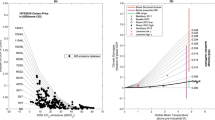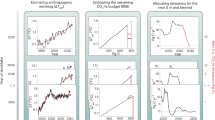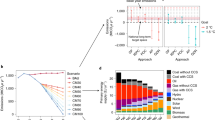Abstract
CURRENT debate on policies for limiting climate change due to greenhouse-gas emissions focuses on whether to take action now or later, and on how stringent any emissions reductions should be in the near and long term. Any reductions policies implemented now will need to be revised later as scientific understanding of climate change improves. Here we consider the effects of a sequential-decision strategy (Fig. 1) consisting of a near-term period (1992–2002) during which either moderate emissions reductions (achieved by energy conservation only) or aggressive reductions (energy conservation coupled with switching to other fuel sources) are begun, and a subsequent long-term period during which a least-cost abatement policy is followed to limit global mean temperature change to an optimal target ΔT*. For each policy we calculate the global mean surface temperature change ΔT(t) using a simple climate/ocean model for climate sensitivities ΔT2x. (the response to doubled CO2, concentrations) of 4.5,2.5,1.5 and 0.5 °C. The policy beginning with moderate reductions is less expensive than that with aggressive reductions if ΔT*>2.9, 2.1, 1.5 and 0.9 °C respectively; otherwise, the aggressive-reductions policy is cheaper. We suggest that this approach should assist in choosing realistic targets and in determining how best to implement emissions reductions in the short and long term.
This is a preview of subscription content, access via your institution
Access options
Subscribe to this journal
Receive 51 print issues and online access
$199.00 per year
only $3.90 per issue
Buy this article
- Purchase on Springer Link
- Instant access to full article PDF
Prices may be subject to local taxes which are calculated during checkout
Similar content being viewed by others
References
Rijsberman, F. R. & Swart, R. J. Targets and Indicators of Climatic Change (Stockholm Environment Institute, 1990).
Wirth, D. A. & Lashof, D. A. Ambio 19, 305–310 (1990).
Hammitt, J. K. & Lempert, R. J. in Proc. Conf. Global Climate Change: Los Alamos National Laboratory, October 21–24, 1991 (eds Rosen, L. & Glasser, R.) (Am. Inst. Phys., in the press).
Houghton, J. T., Jenkins, G. J. & Ephraums, J. J. (eds) Climate Change: The IPCC Scientific Assessment (Cambridge Univ. Press, 1990).
Hafele, W. (ed.) Energy in a Finite World: A Global Systems Analysis (Ballinger, Cambridge, Massachusetts, 1981).
Fisher, J. C. & Pry, R. H. Simple Substitution Model of Technological Change, General Electric Co. Res. Dev. Center Rep. 70-C-215 (Schenectady, New York, 1970).
Maier-Reimer, E. & Hasselmann, K. Clim. Dynam. 2, 63–90 (1987).
Schlesinger, M. E. & Jiang, X. Nature 350, 219–221 (1991).
Lindzen, R. S. Bull. Am. met. Soc. 71, 288–299 (1990).
Hansen, J. & Lebedeff, S. J. geophys. Res. 92, 13345–13372 (1987).
Jones, P. D., Wigley, T. M. L. & Wright, P. B. Nature 322, 430–434 (1986).
National Academy of Sciences Policy Implications of Greenhouse Warming (National Academy, Washington, DC, 1991).
Office of Technology Assessment, US Congress Changing by Degrees: Steps to Reduce Greenhouse Gases. OTA-O-482 (Washington, DC, 1991).
Fickett, A. P., Gellings, C. W. & Lovins, A. B. Scient. Am. 263, 64–74 (1990).
Office of Technology Assessment, U.S. Congress New Electric Power Technologies, OTA-E-246 (Washington, DC, 1985).
Manne, A. S. & Richels, R. G. Energy J. 12, 87–108 (1991).
Nordhaus, W. D. Energy J. 12, 37–65 (1991).
Ausubel, J. H. Nature 350, 649–652 (1991).
Author information
Authors and Affiliations
Rights and permissions
About this article
Cite this article
Hammitt, J., Lempert, R. & Schlesinger, M. A sequential-decision strategy for abating climate change. Nature 357, 315–318 (1992). https://doi.org/10.1038/357315a0
Received:
Accepted:
Issue Date:
DOI: https://doi.org/10.1038/357315a0
This article is cited by
-
The Effect of Green Investments in an Agent-Based Climate-Economic Model
Environmental Modeling & Assessment (2017)
-
Hedging the climate sensitivity risks of a temperature target
Climatic Change (2014)
-
Climate policy under fat-tailed risk: an application of FUND
Annals of Operations Research (2014)
-
The uncertainty about the social cost of carbon: A decomposition analysis using fund
Climatic Change (2013)
-
Climate–society feedbacks and the avoidance of dangerous climate change
Nature Climate Change (2012)
Comments
By submitting a comment you agree to abide by our Terms and Community Guidelines. If you find something abusive or that does not comply with our terms or guidelines please flag it as inappropriate.



